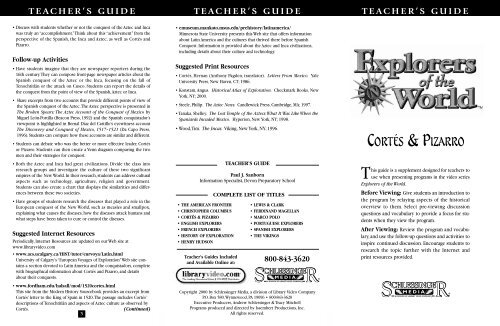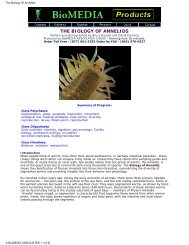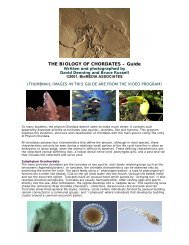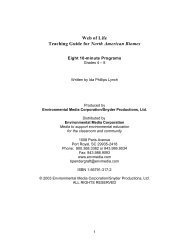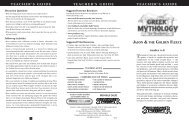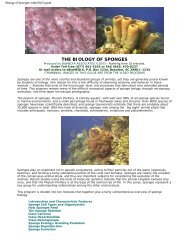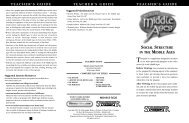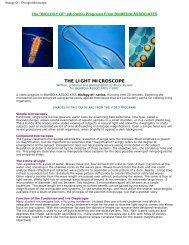CORTÉS & PIZARRO - Distribution Access
CORTÉS & PIZARRO - Distribution Access
CORTÉS & PIZARRO - Distribution Access
You also want an ePaper? Increase the reach of your titles
YUMPU automatically turns print PDFs into web optimized ePapers that Google loves.
TEACHER’S GUIDE TEACHER’S GUIDE TEACHER’S GUIDE<br />
• Discuss with students whether or not the conquest of the Aztec and Inca<br />
was truly an “accomplishment.”Think about this “achievement” from the<br />
perspective of the Spanish, the Inca and Aztec, as well as Cortés and<br />
Pizarro.<br />
Follow-up Activities<br />
• Have students imagine that they are newspaper reporters during the<br />
16th century.They can compose front-page newspaper articles about the<br />
Spanish conquest of the Aztec or the Inca, focusing on the fall of<br />
Tenochtitlán or the attack on Cusco. Students can report the details of<br />
the conquest from the point of view of the Spanish,Aztec or Inca.<br />
• Share excerpts from two accounts that provide different points of view of<br />
the Spanish conquest of the Aztec.The Aztec perspective is presented in<br />
The Broken Spears: The Aztec Account of the Conquest of Mexico by<br />
Miguel León-Portilla (Beacon Press, 1992) and the Spanish conquistador’s<br />
viewpoint is highlighted in Bernal Díaz del Castillo’s eyewitness account<br />
The Discovery and Conquest of Mexico, 1517–1521 (Da Capo Press,<br />
1996). Students can compare how these accounts are similar and different.<br />
• Students can debate who was the better or more effective leader, Cortés<br />
or Pizarro. Students can then create a Venn diagram comparing the two<br />
men and their strategies for conquest.<br />
• Both the Aztec and Inca had great civilizations. Divide the class into<br />
research groups and investigate the culture of these two significant<br />
empires of the New World. In their research, students can address cultural<br />
aspects such as technology, agriculture, religion and government.<br />
Students can also create a chart that displays the similarities and differences<br />
between these two societies.<br />
• Have groups of students research the diseases that played a role in the<br />
European conquest of the New World, such as measles and smallpox,<br />
explaining what causes the diseases, how the diseases attack humans and<br />
what steps have been taken to cure or control the diseases.<br />
Suggested Internet Resources<br />
Periodically, Internet Resources are updated on our Web site at<br />
www.libraryvideo.com<br />
• www.acs.ucalgary.ca/HIST/tutor/eurvoya/Latin.html<br />
University of Calgary’s “European Voyages of Exploration”Web site contains<br />
a section devoted to Latin America and the conquistadors, complete<br />
with biographical information about Cortés and Pizarro, and details<br />
about their conquests.<br />
• www.fordham.edu/halsall/mod/1520cortes.html<br />
This site from the Modern History Sourcebook provides an excerpt from<br />
Cortés’ letter to the King of Spain in 1520.The passage includes Cortés’<br />
descriptions of Tenochtitlán and aspects of Aztec culture as observed by<br />
Cortés. (Continued)<br />
5<br />
• emuseum.mankato.msus.edu/prehistory/latinamerica/<br />
Minnesota State University presents this Web site that offers information<br />
about Latin America and the cultures that thrived there before Spanish<br />
Conquest. Information is provided about the Aztec and Inca civilizations,<br />
including details about their culture and technology.<br />
Suggested Print Resources<br />
• Cortés, Hernan (Anthony Pagden, translator). Letters From Mexico. Yale<br />
University Press, New Haven, CT; 1986.<br />
• Konstam,Angus. Historical Atlas of Exploration. Checkmark Books, New<br />
York, NY; 2000.<br />
• Steele, Philip. The Aztec News. Candlewick Press, Cambridge, MA; 1997.<br />
• Tanaka, Shelley. The Lost Temple of the Aztecs:What It Was Like When the<br />
Spaniards Invaded Mexico. Hyperion, New York, NY; 1998.<br />
• Wood,Tim. The Incas. Viking, New York, NY; 1996.<br />
TEACHER’S GUIDE<br />
Paul J. Sanborn<br />
Information Specialist, Devon Preparatory School<br />
• THE AMERICAN FRONTIER<br />
• CHRISTOPHER COLUMBUS<br />
• <strong>CORTÉS</strong> & <strong>PIZARRO</strong><br />
• ENGLISH EXPLORERS<br />
• FRENCH EXPLORERS<br />
• HISTORY OF EXPLORATION<br />
• HENRY HUDSON<br />
Teacher’s Guides Included<br />
and Available Online at:<br />
COMPLETE LIST OF TITLES<br />
• LEWIS & CLARK<br />
• FERDINAND MAGELLAN<br />
• MARCO POLO<br />
• PORTUGUESE EXPLORERS<br />
• SPANISH EXPLORERS<br />
• THE VIKINGS<br />
800-843-3620<br />
CHLESSINGE<br />
MEDIA S A DIVISION OF LIBRARY VIDEO COMPANY R<br />
®<br />
Copyright 2000 by Schlessinger Media, a division of Library Video Company<br />
P.O. Box 580,Wynnewood, PA 19096 • 800-843-3620<br />
Executive Producers, Andrew Schlessinger & Tracy Mitchell<br />
Programs produced and directed by Issembert Productions, Inc.<br />
All rights reserved.<br />
®<br />
<strong>CORTÉS</strong> & <strong>PIZARRO</strong><br />
This guide is a supplement designed for teachers to<br />
use when presenting programs in the video series<br />
Explorers of the World.<br />
Before Viewing: Give students an introduction to<br />
the program by relaying aspects of the historical<br />
overview to them. Select pre-viewing discussion<br />
questions and vocabulary to provide a focus for students<br />
when they view the program.<br />
After Viewing: Review the program and vocabulary,<br />
and use the follow-up questions and activities to<br />
inspire continued discussion. Encourage students to<br />
research the topic further with the Internet and<br />
print resources provided.<br />
CHLESSINGE<br />
CHLESSINGE<br />
MEDIA S A DIVISION OF LIBRARY VIDEO COMPANY R<br />
®<br />
®
Historical Overview<br />
Spain became a great European power in the 16th century, due to the vast<br />
wealth in precious metals that its explorers discovered in the New World.<br />
Spanish forces under the command of Hernán Cortés and Francisco Pizarro,<br />
two premier conquistadors, acquired untold riches in gold and silver from the<br />
Aztec and Inca civilizations of Central and South America. In the name of<br />
Christianity and the Spanish Crown, a small number of conquistadors conquered<br />
vast territory and peoples.With their superior weaponry and horses,<br />
Hernán Cortés overthrew Montezuma and the Aztec Empire, while Francisco<br />
Pizarro defeated Atahualpa and the Inca Empire, garnering land and treasure<br />
for Spain.As a result of the actions of Cortés and Pizarro, two of the most<br />
developed civilizations in the New World vanished.<br />
Time Line<br />
1513 — Francisco Pizarro reaches the Pacific Ocean with Vasco Núñez de<br />
Balboa.<br />
1518 — Hernán Cortés leaves Cuba for the Yucatán Peninsula in Mexico.<br />
1519 — Cortés lands in Mexico and begins his march on the Aztec, reaching<br />
the Aztec capital city of Tenochtitlán.<br />
1520 — The death of Aztec ruler Montezuma.<br />
1521 — Cortés conquers Tenochtitlán.<br />
1522 — The Spanish found Mexico City on the ruins of Tenochtitlán.<br />
1524 — The beginning of Pizarro’s first expedition to the Inca Empire.<br />
1526 — The beginning of Pizarro’s second expedition to the Inca Empire.<br />
1529 — Spanish king permits Pizarro to conquer the Inca Empire.<br />
1533 — The death of Atahualpa, the last Inca ruler, at Spanish hands.<br />
1535 — Pizarro founds Lima, the new capital city of the conquered Inca<br />
Empire.<br />
Vocabulary<br />
conquistadors — From the Spanish word for “conquerors,” this term refers to<br />
the Spanish explorers who were responsible for the European conquest of the<br />
New World, Mexico and Peru, particularly in the 16th century. Mostly commoners<br />
in their homeland, they sought fame and fortune in the New World. Overall,<br />
the conquistadors were considered to be a group of fierce and ruthless fighters.<br />
Aztec — A group of Central Americans who established a powerful, advanced<br />
empire in the area of present-day Mexico roughly one hundred years before<br />
being conquered by the Spanish led by Hernán Cortés.<br />
Yucatán — A state in the northern Yucatán Peninsula in southeastern Mexico.<br />
Cortés sailed from Cuba to explore the coast of Yucatán in 1518.<br />
(Continued)<br />
Tabasco — A state in southeastern Mexico where Cortés landed in 1519.<br />
Doña Marina — (c.1501–1550) Also known as “La Malinche,” an Indian<br />
princess given as a slave to Cortés and his men. Doña Marina became Cortés’<br />
translator, advisor and companion.<br />
Tenochtitlán — The capital of the Aztec Empire, which Cortés conquered in<br />
1521.<br />
Montezuma — (1466–1520) The ninth Aztec emperor who was held prisoner<br />
by Cortés and was killed during an Aztec revolt in 1520.<br />
noche triste — Spanish term for “sad night,” referring to the time when<br />
Cortés and his men were forced to retreat from the Aztec capital city and<br />
regroup before finally capturing the city and declaring Spanish rule.<br />
smallpox — An infectious disease characterized by fever, sores on the skin<br />
and often death.This disease was responsible for the deaths of many Aztec and<br />
Inca people in the 1500s.<br />
Vasco Núñez de Balboa — (1475–1519) A Spanish explorer and conquistador<br />
who was the first European to sight the Pacific Ocean, which he claimed<br />
for Spain in 1513.<br />
Inca — A group of powerful South Americans who ruled over a large empire<br />
that stretched for some 2,500 miles in northern South America, centered<br />
around today’s Peru. Francisco Pizarro was the Spanish conquistador who conquered<br />
the Inca people during the 16th century.<br />
Atahualpa — (c.1502–1533) The thirteenth and final emperor of the Inca<br />
Empire who was killed by the Spanish in 1533.<br />
Cusco — The capital of the Inca Empire, which was captured by Francisco<br />
Pizarro following Atahualpa’s death in 1533.<br />
Lima — The new capital of Peru established by Pizarro in 1535 after the<br />
defeat of the Inca Empire.<br />
Pre-viewing Discussion<br />
• Both Cortés and Pizarro conquered peoples who greatly outnumbered the<br />
Spanish conquistadors. How can this phenomenon be explained? Have students<br />
discuss possible reasons that might explain why the Spanish achieved<br />
their successes.<br />
• For the length of their conquests, Pizarro and Cortés remained faithful to<br />
their king and sent to Spain the great wealth they had gained from the Inca<br />
and Aztec. Brainstorm reasons why they didn’t keep the wealth for themselves.<br />
• Cortés and Pizarro engaged in many cruel, ruthless and aggressive behaviors<br />
to conquer native people and establish a Spanish empire.What character<br />
traits do you think these men possessed in order to accomplish these<br />
deeds? How might these men have justified their behavior?<br />
2 3<br />
Focus Questions<br />
1.Where was New Spain located?<br />
2. How large was New Spain in relation to Spain itself?<br />
3. Describe some characteristics of Aztec society.<br />
4.Why were slaves given to Cortés as a gift by native peoples he encountered<br />
as he landed on the Yucatán Peninsula?<br />
5. How was Doña Marina involved in the conquest of the Aztec Empire?<br />
6.Why did Cortés burn his own ships?<br />
7.What role did Aztec myth play in Cortés’ invasion of the Aztec Empire?<br />
8.Who was Montezuma and how did the Spanish treat him?<br />
9.Why did the Spanish retreat from the Aztec capital?<br />
10. How did the Spanish finally destroy Tenochtitlán?<br />
11. How was Cortés rewarded for his conquest?<br />
12.What type of ruler did Cortés become in New Spain?<br />
13. Describe some characteristics of Inca society.<br />
14.What does it mean to say that Pizarro “drew a line in the sand”?<br />
15.Who was Atahualpa and how did Pizarro interact with him?<br />
16. How did Pizarro consolidate Spanish control in the Inca Empire?<br />
17.Why did the Spanish build a new capital in Peru at Lima rather than use<br />
the old Inca city of Cusco?<br />
18. How did Pizarro come to his end?<br />
19. How did disease help the Spanish conquer the Inca and Aztec?<br />
Follow-up Discussion<br />
• Discuss with students what technology and cultural advantages the<br />
Spanish had over the native people of the New World that helped them<br />
make conquests with relatively small numbers of men. Could the Spanish<br />
have achieved their conquests if it had not been for disease?<br />
• Have students discuss whether they agree or disagree with Cortés’ decision<br />
to burn his ships at the beginning of his march on Tenochtitlán.Was<br />
this an effective decision? Would students have burned their ships if they<br />
had been in Cortés’ position?<br />
• Both the Aztec and Inca enjoyed advanced, sophisticated civilizations for<br />
their time and location; yet both empires were conquered by the Spanish.<br />
Have students generate suggestions for how these two cultures might<br />
have better met the challenges presented to them at the time of Spanish<br />
conquest.<br />
• Doña Marina was a powerful woman who, through her interactions with<br />
Cortés, had a significant influence on the development of world history.<br />
Encourage students to discuss Doña Marina’s role in history as a heroine<br />
or a traitor.<br />
4<br />
(Continued)


